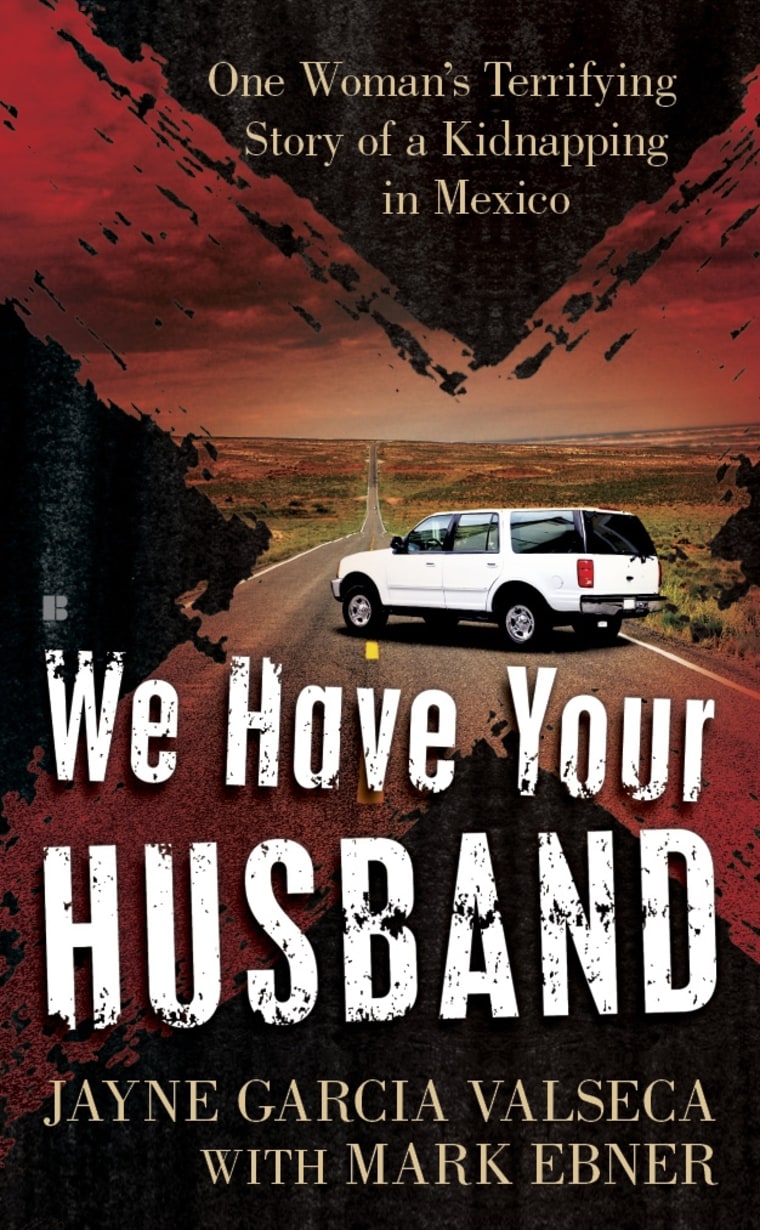In 2007, after driving their three children to school, Jayne and Eduardo Valseca were kidnapped. Jayne eventually managed to escape, but her husband was held captive for more than seven months, enduring unimaginable conditions. In "We Have Your Husband: One Woman's Terrifying Story of a Kidnapping in Mexico," Jayne writes about her family's terrifying ordeal. Read an excerpt.
“Look at this asshole,” Eduardo said in Spanish. “What the hell is he doing?”
We both thought the same thing at the same time — that we should turn around and go back to the school and call someone. But as he was headed straight at us, and we would pass him in another five seconds, I said, “Let’s go to the house and call the cops.” He flew by us in a flash, and we made the turn onto the public road, but now the Ford KA that had been following us kept going straight into our alfalfa field, now separated from us by a barbed-wire fence. As we watched him through the breaks in the mesquite trees and waist-high grass, Eduardo with half a mind to follow him and tell him he was on private property, we noticed there were two cars ahead of us moving slower than we were. This allowed the KA to speed up and cut in front of both of them at the next break in the fence line.
He’d been waiting in the parking lot, and now he couldn’t wait to get around us? In fact, there in front of us, then almost immediately began to slow down.

Just up ahead of us, at the halfway point between our house and the school, the road narrows, flanked by a dense copse of mesquite trees on one side and órgano cactus (named for its similarity to a pipe organ) on the other that squeeze the narrow passage like the fingers of a hand. It was here that the Yukon suddenly slammed on its brakes, so that Eduardo just barely missed smashing into it. A second later, a different pickup truck appeared out of nowhere and rammed us from behind, pushing us almost flush up against the Yukon. We both turned to see what had happened, and in the one second it took us to turn back around, two men were out of the Yukon and at our windows. The one on Eduardo’s side had a handgun and a hammer, and with a single blow from the gun butt he shattered the driver’s-side window. I could hear Eduardo screaming as they dragged him from the Jeep and struck him in the head once with the hammer. There was blood everywhere.
The man on my side had a gun and a club, but my door wasn’t locked so he simply opened it. He pointed his gun at me and tried to force me from the car with his free hand, but I grabbed onto the barbed-wire fence and refused to let go. I kicked at him with my flip-flops until he finally wrestled me to the ground, ripping my hands from the fence and opening up my left index finger like a ripe banana. He put the barrel of the gun against my forehead — a silver nine-millimeter pistol with a gold stripe down the barrel — and told me to get up. I stopped fighting, and he took me by the arm and put me in the middle seat of the Yukon. I heard myself say, “Don’t kill me, I have children.”
The second I hit the seat, someone from behind pulled a thick cotton pillowcase over my head and drew an elastic drawstring tightly around my neck. I was afraid I was going to hyperventilate, and I told them I couldn’t breathe. They finally pulled the edge up over my nose, which gave me a limited view of my surroundings. I instinctively reached to my left for Eduardo’s arm and could see that he had been handcuffed. His whole arm was sticky with blood, and I started to worry he would go into shock. I told him, “You have to calm down; you have to use your mind.” The man driving yelled, “Cállate!” — “Shut up!” — in a deep guttural voice that sounded like he was intentionally disguising it. But there were two things that were odd about it: One was that he was extremely calm. The second was that his accent didn’t come from any one place. It was just generically Mexican. In Mexico, that’s a rarity.
“God is great,” I said to Eduardo. “Dios es muy grande.” I also wanted to remind the kidnappers of God. We were in a Catholic country and I assumed that the kidnappers were Catholic. At a moment like this, I thought reminding them of God may save our lives. I felt a finger encased in a tight leather glove tap lightly against my lips, an action repeated every time I tried to whisper something to Eduardo. It’s a gesture you would make to a small child — one meant to convey seriousness but also to comfort. At the time, I interpreted it as an act of kindness, and I instinctively reached out for his hand. I had read a book on miracles and remembered that many people who had been victims of violent crimes or come face-to-face with serial killers had survived because they established empathy with their assailant. I asked him if he had children. Instead, he folded my hands on my stomach and gently patted my belly. When I told him I needed medical attention for my finger, he pulled the pillowcase back down over my face so I couldn’t see.
Excerpted with permission from “We Have Your Husband: One Woman's Terrifying Story of a Kidnapping in Mexico” by Jayne Garcia Valseca with Mark Ebner. Published by Berkley. Copyright © 2011